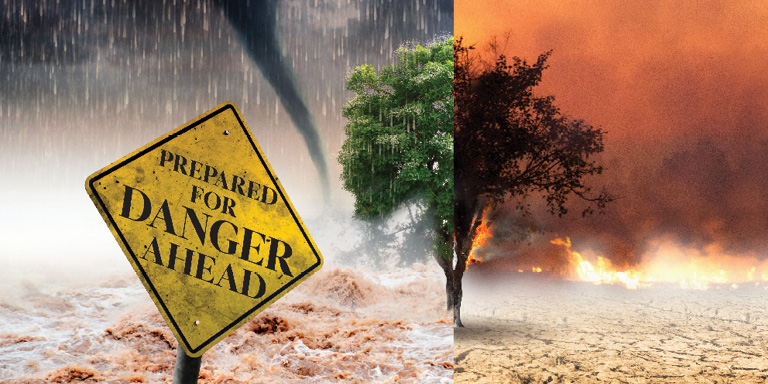Prepared for Danger Ahead
AAMVA’s Emergency Resiliency and Response working group is creating a framework to keep your business operating when an emergency strikes
An emergency can mean any number of things—a city-wide power outage, severe flooding ruining hundreds of homes, even a civic protest that shuts down roads. While most motor vehicle agencies know of these events in advance and can prepare for them, the COVID-19 pandemic took everyone by surprise. The pandemic not only altered perceptions about what constitutes an emergency, it underscored a critical concern for AAMVA members: How can motor vehicle offices keep operating while keeping their staff and the public safe?
How motor vehicle offices responded during the COVID-19 outbreak varied by jurisdiction. While some continued all in-person services, others paused business activity altogether. Yet many offices were able to keep operating by working remotely. With such a diverse response, it was clear that administrators and program managers benefited from sharing their operating strategies during COVID-19.
AAMVA formed the Emergency Response and Resiliency (ERR) working group in late summer of 2021, after numerous discussions with members about how they managed operations during the COVID-19 crisis. Comprised of communications experts, IT professionals, attorneys and administrators from all parts of the U.S. and Canada, group members bring a diversity of thought and experience about emergency planning.
“Every jurisdiction faces different types of disasters due to their different geography, population and the unique risks they face,” says Kristen Shea, AAMVA’s senior programs analyst and the project manager for the working group. “Since emergencies are multi-faceted, the response to them must also be multi-faceted to succeed.”
Defining an emergency
Since each jurisdiction defines disaster differently, the working group chose the term “emergency” because it covered all situations that could affect members. Amy Williams, assistant general counsel for the Illinois Secretary of State Office and chair of the working group says an emergency is “any event that forces you to break away from normal operations for a short time.”
With this definition in mind, the working group has created a framework for developing an emergency plan (also known as the continuity of operations) that is specific to each agency’s needs, Williams says. The framework plan covers three phases of operations: 1) taking care of employees; 2) providing services to the public, and 3) planning for reopening. Further, the plan identifies who is in charge at each phase and what steps should be done in sequence. Most important, it is a living document that should be reviewed and updated as new situations arise.
“During the pandemic, jurisdictions didn’t have the framework in place to keep operations running. That spurred our discussion about what we can do now to prepare for future events,” Williams says.
As part of this framework, the working group is producing two resources to assist members with emergency planning. The first is a digital toolkit with a checklist of tasks and resources for different types of emergencies. The second document shares best practices for IT, communications and working with partners. Shea says these documents are scheduled to be available to members in early 2023.
Texas-sized case study
The state of Texas has seen its share of emergencies over the years. According to data from NASA, Texas is ranked number one in the U.S. in the variety and frequency of natural disasters. Weather-related events like hurricanes, tornadoes, floods, wildfires, sink holes, erosion and drought are common.
Yet it was the COVID-19 pandemic that tested the state’s ability to keep operations going, says Jimmy Archer, director of the Motor Carrier Division at the Texas Department of Motor Vehicles in Austin and a member of the working group.
“We closed offices for a period of time, and many employees had to telecommute. We were able to transition to remote operations swiftly without missing any service time,” Archer says.
He attributes that seamless transition to the continuity of operations plan that the Texas DMV has had in place. It contains several key components, such as how to communicate with employees, critical business functions that might be affected, alternate facilities that the agency can operate from, and a roster of personnel to contact for assistance.
The plan has become more detailed and sophisticated over the years and the agency frequently tests aspects of the plan, such as the computer systems to make sure they are protected against potential cyber-attacks.
The best way motor vehicle agencies can deal with emergencies is with awareness and preparedness. “Awareness comes from knowing the types of situations you might face and what steps you should take in response,” Archer says. That includes making sure staff understands their responsibilities.
Preparedness comes from knowing what to do and when. “Figure out ahead of time how to keep the team safe and what you can do to assist the public, even if everyone is working remotely,” Archer says. “Find out if other state agencies might need your department’s help in case an emergency affects them directly. Once you have an emergency plan in place, you understand better how to get through those difficult situations.”
Action steps
While early versions of emergency plans focused on how to repair buildings after a tornado, they didn’t address the loss of operations or staffing issues, Williams says. “The COVID pandemic taught us that plans need to be flexible to address the next unknown,” she says.
Whether developing a new emergency plan or dusting off an existing one, the working group suggests the following action steps.
Regularly review and update the plan
“In an emergency, you won’t have time to review your plan, so you need to know ahead of time who to contact and what steps to take,” says Shea.
The nature of risk can change over time, she adds. For example, 15 years ago, some areas weren’t prone to wildfires, but now, more are seeing them occur. The changing nature of emergencies calls for a regular review of emergency plans, as often as every six months to one year, to make sure those risks are addressed.
Keep communications open with staff and partners
Find ways to communicate with staff during an emergency, whether through a phone tree, text messaging or a chat room. Make sure everyone understands what is happening, what tasks they are responsible for and, most importantly, how they can continue to serve the public, even if they are working remotely.
Keep current with IT needs
Keep IT departments current with the latest equipment and software so staff can operate during an emergency. “IT teams need to know what resources are available so they can prepare for future emergencies. For example, will they be able to provide employees with laptops so they can work remotely?” Williams says.
Be prepared to adapt to rapidly changing circumstances
In an emergency, jurisdictions may need to respond quickly and creatively to unusual circumstances. Shea says when the pandemic forced staff to work remotely, one jurisdiction in which some employees did not have business email overcame communications challenges by setting up a virtual breakroom to post updates and keep everyone informed. That creative problem-solving can serve agencies well.
Emergencies can happen at any time. An emergency response plan can help you be prepared to serve your staff and community without disrupting your business.
Listen to our AAMVACAST episode on this topic at tinyurl.com/3fnm93nd.




